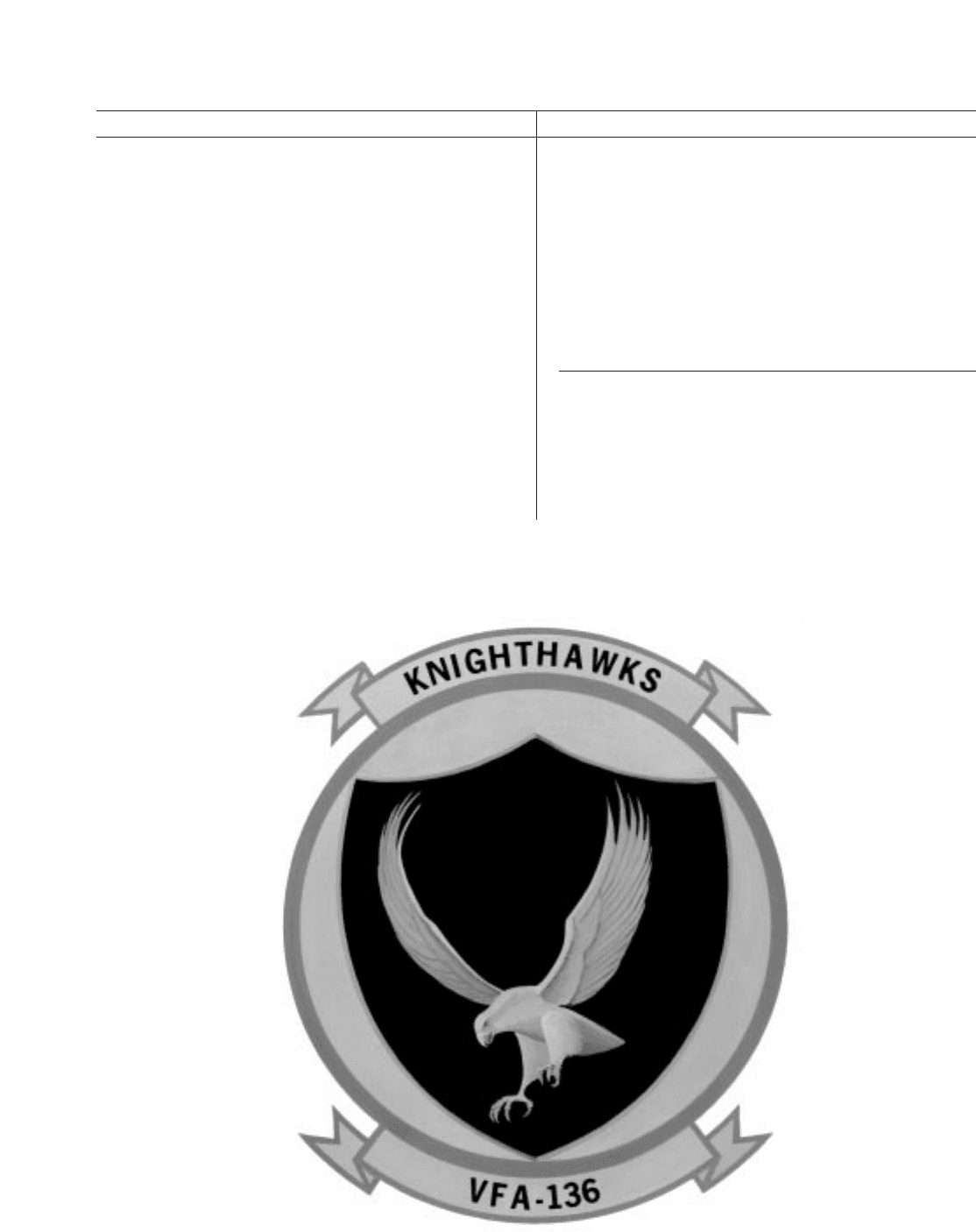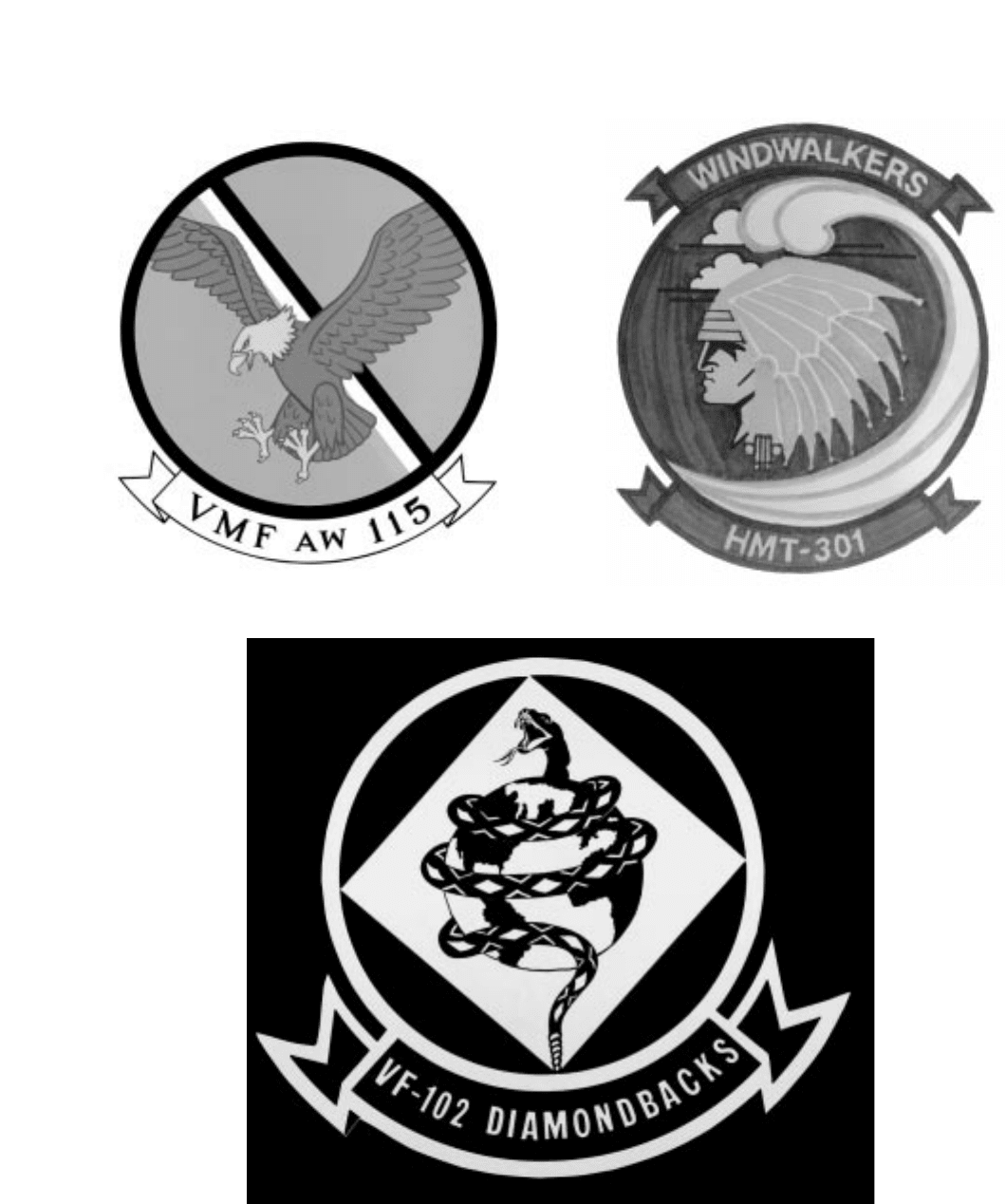Grossnick Roy A. United States Naval Aviation, 1910-1995
Подождите немного. Документ загружается.


Slack,Albert C. USN
Smith,Armistead B.,Jr. USN
Smith,Carl E. USN
Smith,Clinton L. USN
Smith,Daniel F., Jr. USN
* Smith, John L. USMC
Smith,John M. USN
Smith,Kenneth D. USN
Smith,Nicholas J.,III USN
Snider,William N. USMC
Sonner,Irl V., Jr. USN
Southerland,James J.,III USN
* Spears, Harold L. USMC
Spitler,Clyde P. USN
Stanbook,Richard E. USN
Stanley, Gordon A. USN
Starkes,Carlton B. USN
Stebbins,Edgar E. USN
Stewart,James S. USN
* Stimpson,Charles R. USN
Stokes,John D. USN
Stone,Carl V. USN
Stout,Robert F. USMC
Strane,John R. USN
Strange,Johnnie C. USN
Streig,Frederick J. USN
Sturdevant,Harvey W. USN
Sutherland,John F. USN
* Swett,James E. USMC
Swinburne,Harry W., Jr. USN
Swope,James S. USN
Symmes,John C.C. USN
Synar,Stanley T. USMC
Taylor,Ray A.,Jr. USN
Taylor,Will W. USN
Terrill,Francis A. USMC
Thach,John S. USN
Thelen,Robert H. USN
Thomas,Franklin C.,Jr. USMC
Thomas,Robert F. USN
* Thomas,Wilbur J. USMC
Toaspern,Edward W. USN
Topliff,John W. USN
Torkelson,Ross E. USN
Townsend, Eugene P. USN
Tracey, Fredrick W. USN
Troup,Franklin W. USN
Trowbridge, Eugene A. USMC
Traux,Myron M. USN
Turner,Charles H. USN
Turner,Edward B. USN
Twelves,Wendell V. USN
Ude,Vernon R. USN
Prichard,Melvin M. USN
Quiel,Norwald R, USN
** Ramlo, Orvin H. USMC
Reber,James V., Jr. USN
Redmond,Eugene D. USN
Register,Francis R. USN
Rehm,Dan R.,Jr. USN
Reidy,Thomas H. USN
Reinburg,Joseph H. USMC
Reiserer,Russell L. USN
Rennemo,Thomas J. USN
Reulet,Joseph E. USN
Revel,Glenn M. USN
Rhodes,Thomas W. USN
Rieger,Vincent A. USN
Rigg,James F. USN
Roach,Thomas D. USN
Robbins,Joe D. USN
Robinson,Leroy W. USN
Robinson,Ross F. USN
Rosen,Ralph J. USN
Ross,Robert P. USN
Rossi,Herman J.,Jr. USN
Ruhsam,John W. USMC
Runyon, Donald E. USN
Rushing,Roy W. USN
Sapp, Donald H. USMC
Sargent,John J.,Jr. USN
Savage, Jimmie E. USN
Scales,Harrell H. USN
Scarborough,Hartwell V., Jr. USMC
Schecter,Gordon E. USN
Schell,John L. USN
Scherer,Raymond F. USMC
Schiller,James E. USN
Schneider,Frank E. USN
Seckel,Albert,Jr. USN
See,Robert B. USMC
Segal,Harold E. USMC
Self,Larry R. USN
Shackford,Robert W. USN
Shands,Courtney USN
Shaw, Edward O. USMC
Sherrill,Hugh V. USN
Shields,Charles A. USN
Shirley, James A. USN
Shuman,Perry L. USMC
Sigler,Wallace E. USMC
Silber,Sam L. USN
Singer,Arthur,Jr. USN
Sipes,Lester H. USN
Sistrunk,Frank USN
Skon,Warren A. USN
UNITED STATES NAVAL AVIATION 1910–1995 681
Name Service Time Frame **** Name Service Time Frame ****

Umphfres,Donald E. USN
* Valencia,Eugene A. USN
Valentine,Herbert J. USMC
Van Der Linden,Peter J.,Jr. USN
Van Dyke,Rudolph D., Jr. USN
Van Haren,Arthur, Jr. USN
Vedder, Milton N. USMC
Vejtasa,Stanley W. USN
Vineyard, Merriwell W. USN
Vita,Harold E. USN
Voris,Roy M. USN
Vorse,Albert O., Jr. USN
* Vraciu,Alexander USN
Wade,Robert USMC
* Walsh,Kenneth A. USMC
Ward,Lyttleton T. USN
Warner,Arthur T. USMC
Watson,Jack O. USN
Watts,Charles E. USN
Webb,Wilbur B. USN
Weissenberger, Gregory J. USMC
Wells,Albert P. USMC
Wesolowski,John M. USN
West,Robert G. USN
White,Henry S. USN
Williams,Bruce W. USN
Williams,Gerard M.H. USMC
Wilson,Robert C. USN
Winfield,Murray USN
Winston,Robert A. USN
Winters,Theodore H.,Jr. USN
Wirth,John L. USN
Wolf,John T. USN
Wood,Walter A. USN
Wooley,Millard J. USN
Woolverton,Robert C. USN
Wordell,Malcolm T. USN
Wrenn,George L. USN
Yeremain,Harold USN
Yost,Donald K. USMC
Yunck, Michael R. USMC
Zaeske,Earling W. USN
Zink,John A. USN
* Aces with 15 kills or more.
** Unconfirmed as aces in World War II.
*** Ace status acquired from combined kills of World War II and Korea.
**** Timeframe is World War II unless indicated otherwise.
682 UNITED STATES NAVAL AVIATION 1910–1995
Name Service Time Frame **** Name Service Time Frame ****

During the last two years of the war, many of the
aircraft assigned to the carriers in the Pacific carried
symbols denoting the ship or air group to which they
were assigned. No directive specifying these markings
are known to exist, if there ever were any. From a
review of photos of the period, it appears that the
symbols were assigned to the CV designated aircraft
carriers. While the Escort Carriers, designated CVE,
had the symbol assigned to the squadrons that operat-
ed aboard the CVEs. Squadrons operating aboard the
CVs only had that specific symbol while assigned to
that particular carrier. While this was a step in the right
direction, the lack of a uniform system was soon
apparent when a large number of aircraft were trying
to rendezvous after takeoff, before landing or over tar-
get areas.
The United States Navy Air Force, Pacific Fleet,
issued a standard set of twenty-eight geometrical
designs for the CV and CVL class carriers which consti-
tuted Task Force 58. These designs were assigned to
the vessel and were applied to all aircraft of the
attached air group as long as it was aboard. They were
applied to both sides of the fin and rudder. While the
drawings in the directive only showed the design on
the top surface of the right wing, subsequent direc-
tives indicate that it was also to be applied on the
under surface of the left wing tip.
The Commander, Air Force, Pacific Fleet, on 11
February 1945, issued an instruction for the aircraft in
the Hawaiian Sea Frontier. All carrier and training type
aircraft were to be identified with a letter followed by
the individual aircraft number running from 1 to 99.
These markings were not for the purpose of security,
but rather to identify U.S. Navy aircraft after numerous
reports of violations of air discipline involving flying
too close to transport aircraft and ground installations.
Air Force, Pacific Fleet, on 2 June 1945, prescribed a
series of recognition symbols for CVEs. These mark-
ings were to be painted on both sides of the vertical
tail surfaces, as well as the upper right and lower left
wing tips. All CVEGs, MCVGs and VCs assigned to
ships of the Escort Carrier Force, Pacific, were to carry
these designs. Each Carrier Division was assigned a
The rapid and accurate identification of aircraft has
always been of prime importance within Naval
Aviation. The explosive expansion of Naval Aviation
during World War II compounded this problem.
A three-part identification system had been in use in
the fleet from 1923 until World War II. Under this sys-
tem, the aircraft identification number 5-F-1, which was
placed on the fuselage of the plane, meant this was the
first airplane in Fighting Squadron 5. After July 1937,
the squadron number for carrier based squadrons was
the same as the hull number of the carrier. Thus
Yorktown (CV 5) would have had VB-5, VS-5 and VF-5
assigned as part of her complement of squadrons. This
system was modified by Commander Carriers, Pacific
Fleet, on 29 April 1942. To help conceal the identity of
carriers engaged in operations in enemy waters, the
squadron number was eliminated, leaving just the letter
designating the type of squadron and the aircraft num-
ber within the squadron. Thus, the marking on the
fuselage of the plane would have been F-1 to identify
it as the first plane in a fighting squadron without iden-
tifying the squadron’s number. This was further modi-
fied on 22 December 1943, by the deletion of the
squadron type letter. All identification as to a specific
unit was now removed which allowed aircraft to be
drawn from a pool as necessary without the require-
ment of painting identification information on them.
During World War II, with the increase in the num-
ber of fleet aircraft operating in the same area as train-
ing planes, the necessity grew even more acute to
quickly differentiate the large number of training
planes from the operational fleet aircraft. To alleviate
this problem, Naval Air Operational Training
Command, on 12 January 1943, directed that all air-
craft within the command be identified by an
alpha/numeric system consisting of three groups of
characters. The first letter(s) designated the base
assignment for the aircraft. The second letter identified
the aircraft mission, while the third group was the
number of the aircraft within the squadron. For an
example, V-T-29 would indicate the aircraft was from
Vero Beach, Fla., it was a torpedo plane, and the 29th
aircraft in that Vero Beach, Fla., training unit.
UNITED STATES NAVAL AVIATION 1910–1995 683
683
APPENDIX 23
Visual Identification System for
Naval Aircraft (Tail Codes)

basic design. The position of the individual vessel
within the Division was indicated by a series of nar-
row stripes.
The system of geometrical symbols carried by Task
Force 58 aircraft was difficult to describe over the
radio and was not always readily identifiable in the air.
To eliminate this problem, Commander Task Force 38,
in July 1945, specified a system of 24-inch block capi-
tal letters to be used to identify the aircraft of the CVs
and CVBs. These letters were to be applied to both
sides of the fin and rudder as well as the top right and
lower left wing tips. In its original form some ships
used a single letter, while others were assigned double
letters. This was the beginning of the two-letter Visual
Identification System in use today.
Naval Air Stations in Hawaii were assigned letter
designations on 10 September 1945, by the
Commander, Air Force, Pacific Fleet. These letters
were to be followed by a number from 1 to 99 inclu-
sive. In the event all available numbers in the 1 to 99
series were used, and no additional letters were avail-
able, the use of numbers over 100 was authorized.
On 8 January 1946, Air Force, Pacific Fleet, issued
instructions for the application of markings on the fast
carrier aircraft. This directive also assigned new alpha-
betical designations for the CVs and CVBs and CVLs in
place of those specified by Commander Task Force 38.
This assignment of the same letter to a different carrier
than previously designated, may well have caused the
erroneous identification of some photographs as to
what ship the aircraft were actually assigned.
All of the previous directives or instructions were a
search for an easy system to rapidly identify aircraft.
Finally, on 7 November 1946, the Chief of Naval
Operations (CNO) established the Visual Identification
System for all Navy and Marine Corps aircraft. To be
effective, such a system had to be simple, readable
and possess enough different combinations to cover
the number of aircraft carriers and all types of
squadrons to which naval aviation might expand in
case of war. A system using letters satisfies these
requirements as long as distinctive characters are used.
The elimination of the ambiguous letters G, J, N, O, Q
and Y left ample combinations to cover such expan-
sion. Since each letter has a phonetic equivalent in
communication procedures, the problem of describing
geometric markings was replaced by the simple pro-
cess of enunciating the names of the letters of the
alphabet. Under this system each aircraft carrier had
either a single or double letter symbol, some of which
were a hold over from the previous system. On 12
December 1946, the Visual Identification System of
Naval Aircraft was modified by CNO. Under this
change the tail codes assigned to the carriers were
now reassigned to individual air groups. This permit-
ted greater flexibility since an air group was not per-
manently assigned to a specific carrier.
Under the CNO system, non-carrier based
squadrons, such as VP, VPP, VPW, VPM, VU, VRU, VX
and VCN squadrons also used a letter system. In these
squadrons the first of the two letters designated the
wing or class while the second letter designated the
squadron within the wing. Marine Corps carrier-based
squadrons used the letters assigned to the parent carri-
er. While shore-based Marine squadrons used the first
letter to designate the Wing or other command, and
the second letter identified the squadron within the
Wing or Command. The letters in all cases were
underscored to denote Marine. It was possible under
this system to have the same code letters assigned to a
Navy squadron and a Marine Corps squadron concur-
rently. This requirement to underscore the letters on
Marine Corps aircraft was rescinded on 4 August 1948.
The Training Command continued to use the letter
number designation system in which the first of one or
two letters designated the base or station, while the
second letter identified the squadron and/or class des-
ignation. The aircraft within the squadron were identi-
fied by a one, two or three digit number. The Chief,
Naval Air Training, controlled the assignment of the
letter symbols within the Training Command.
Naval Air Reserve aircraft were also identified by
two letters. The first letter denoted the Air Station to
which the aircraft was assigned, while the second let-
ter identified the type of squadron. From this it can be
seen that it was possible to have a fleet squadron and
a reserve squadron identified with the same two let-
ters. This was resolved by the use of the orange belly
band around the fuselage to denote a Reserve aircraft.
Reorganization of the Naval Air Reserve in 1970
arranged the reserve squadron system along the same
lines as the active fleet structure. The tail code assign-
ments for these squadrons was redone to following
the procedures used for the fleet squadrons.
Naval Air Advanced Training Command on 6
January 1947 issued a directive for identifying aircraft
within the command. This alpha/numeric system used
a letter to identify the Naval Air Station, followed by a
second letter designating the squadron at that activity
and then a three digit aircraft number. On 31 August
1950, the Chief Naval Air Basic Training issued a
direcitve that involved single letters to denote aircraft
assigned to the various bases. This was modified on
27 September 1950 to a two-letter system whereby the
first letter designated the base and the second letter
the squadron. These letters were followed by a three-
digit number to denote the individual aircraft within
the squadron. On 6 September 1956, Chief of Naval
Air Training established a new tail code identification
system for the training commands. This system included
684 UNITED STATES NAVAL AVIATION 1910–1995

VR-48 JR
VR-52 JT
VR-53 WV
VR-54 CW
VR-55 RU
VR-56 JU
VR-57 RX
VR-58 JV
VR-59 RY
VR-61 RS
VR-62 JW
Helicopter Antisubmarine Light
HSL-37 TH
HSL-40 HK
HSL-41 TS
HSL-42 HN
HSL-43 TT
HSL-44 HP
HSL-45 TZ
HSL-46 HQ
HSL-47 TY
HSL-48 HR
HSL-49 TX
HSL-51 TA
HSL-84 NW
HSL-94 NW
Naval Air Systems Command
Test Pilot School TPS
MARTD’S/Marine Support
HQMC 5A
MCAS Beaufort 5B
MCAS Cherry Point 5C
MCAS El Toro 5T
MCAS Futenma 5F
two character alpha/numberic codes whereby the
number 2 designated Chief Naval Air Basic Training
Command aircraft, 3 designated Chief Naval Air
Advanced Training Command and 4 designated Chief
Naval Technical Training Command aircraft.
One major change to occur was the move from a
single letter to two letters to idenify an air group’s tail
code. The effective date for this change was most like-
ly the beginning of Fiscal Year 1958 (1 July 1957).
Specific documenation has not been discovered to ver-
UNITED STATES NAVAL AVIATION 1910–1995 685
ify this date. However, the tail code (Visidual
Identification System) listing in the Naval Aeronautical
Organization for 1957 shows the changes for the air
group tail codes to two letters.
Even though numerous changes have been made
since 7 November 1946 to the Visual Identification
System, the basic tenet of the system has remained
intact. The following is a listing of Tail Codes (Visual
Identification System for Naval Aircraft) for Naval
Aviation as of the end of 1995:
Blue Angels BA
Carrier Air Wings (former designation Carrier Air Groups)
CVW-1 AB
CVW-2 NE
CVW-3 AC
CVW-5 NF
CVW-7 AG
CVW-8 AJ
CVW-9 NG
CVW-11 NH
CVW-14 NR
CVW-17 AA
RCVW-4* AD
RCVW-12** NJ
CVWR-20 AF
Carrier AEW
CAEWW-12 GE
ASW Air Groups
CVSG-50*** AR
CVSG-51**** RA
HELWINGRES NW
Fleet Composite
VC-6 JG
VC-8 GF
Fleet Logistic Support
VRC-30 RW
VRC-40 JK
Fleet Logistics Support Reserve
VR-46 JS
Command Tail Code Command Tail Code

MCAS Iwakuni 5G
MCAS New River 5D
MCAS YUMA 5Y
Naval Air Stations (NAS)
Alameda 7J
Brunswick 7F
Cecil Field 7U
Fallon 7H
Jacksonville 7E
Key West 7Q
Lemoore 7S
Memphis 7K
Norfolk 7C
North Island 7M
Oceana 7R
Patuxent River 7A
Point Mugu 7L
Whidbey Island 7G
Naval Air Warfare Center Weapons Division
China Lake 7P
Naval Air Warfarfe Center Naval Aircraft Division
Patuxent River SD
Navy Support
NAF Atsugi 8A
NAF El Centro 8N
NAVSTA Guam 8J
NAVSTA Guantanamo 8F
NAVSTA Mayport 8U
NAF Mildenhall 8G
NAF Misawa 8M
COMFLTACT Okinawa 8H
NAVSTA Roosevelt Roads 8E
NAVSTA Rota 8D
NAS Sigonella 8C
HQ CMEF (Bahrain) 8K
Helicopter Combat Support
HC-2 HU
HC-3 SA
HC-4 HC
HC-5 RB
HC-6 HW
HC-8 BR
HC-11 VR
HC-85 NW
Patrol
VP-1 YB
VP-4 YD
VP-5 LA
VP-8 LC
VP-9 PD
VP-10 LD
VP-11 LE
VP-16 LF
VP-26 LK
VP-30 LL
VP-40 QE
VP-45 LN
VP-46 RC
VP-47 RD
VPU-1 OB
VPU-2 SP
Patrol Reserve
VP-62 LT
VP-64 LU
VP-65 PG
VP-66 LV
VP-68 LW
VP-69 PJ
VP-91 PM
VP-92 LY
VP-94 PZ
Air Test and Evaluation
VX-1 JA
VX-9 XE
Antarctic Development
VXE-6 XD
Helicopter Mine Countermeasure Squadron
HM-14 BJ
HM-15 TB
Fleet Tactical Readiness Group
COMFEWSG GD
686 UNITED STATES NAVAL AVIATION 1910–1995
Command Tail Code Command Tail Code

VMFA-235 DB
VMFA-251 DW
VMFA-312 DR
VMFA-314 VW
VMFA-323 WS
VMFA-451 VM
Tactical Electronic Warfare
VMAQ-1 CB
VMAQ-2 CY
VMAQ-3 MD
VMAQ-4 RM
Aerial Refueler/Transport
VMGR-152 QD
VMGR-252 BH
VMGR-352 QB
Observation
VMO-1 ER
VMO-2 UU
Fleet Training
VMAT-203 KD
VMFAT-101 SH
VMFT-401 WB
Fleet Readiness
VMGRT-253 GR
Helicopter Heavy
HMH-361 YN
HMH-362 YL
HMH-363 YZ
HMH-366 HH
HMH-461 CJ
HMH-462 YF
HMH-463 YH
HMH-464 EN
HMH-465 YJ
HMH-466 YK
Helicopter Medium
HMM-161 YR
HMM-162 YS
Fleet Air Reconnaissance
VQ-1 PR
VQ-2 JQ
VQ-3 TC
VQ-4 HL
VQ-5 SS
VQ-6 ET
Fleet Marine and Marine Support Units
Headquarters
MWHS-1 SZ
MALS-10 SE
MALS-11 TM
MALS-12 WA
MALS-13 YU
MALS-14 CN
HAMS-16 WW
MALS-24 EW
MALS-26 EL
HQSQDN-17 CZ
MALS-31 EX
MALS-36 WK
HQSSDN-37 QF
Attack
VMA-211 CF
VMA-214 WE
VMA-223 WP
VMA-231 CG
VMA-331 VL
VMA-513 WF
VMA-542 CR
All-weather Attack
VMA(AW)-332 EA
All-weather Fighter Attack
VMFA(AW)-121 VK
VMFA(AW)-224 WK
VMFA(AW)-242 DT
VMFA(AW)-225 CE
VMFA(AW)-533 ED
Fighter Attack
VMFA-115 VE
VMFA-122 DC
VMFA-212 WD
UNITED STATES NAVAL AVIATION 1910–1995 687
Command Tail Code Command Tail Code

HMM-163 YP
HMM-164 YT
HMM-165 YW
HMM-166 YX
HMM-261 TV
HMM-262 ET
HMM-263 EG
HMM-264 EH
HMM-265 EP
HMM-266 ES
HMM-268 YQ
HMM-364 PF
HMM-365 YM
Helicopter Light
HMLA-167 TV
HMLA-169 SN
HMLA-267 UV
HMLA-269 HF
HMLA-367 VT
HMLA-369 SM
Helicopter Training
HMT-204 GX
HMT-301 SU
HMT-303 QT
Helicopter
HMX-1 MK
Unmanned Aerial Vehical Operations
1st UAV FZ
2d UAV FF
FAST FS
C Company FH
VC-6 Det FR
DUTCH FD
Chief of Naval Air Training
TRAWING ONE
Meridian A
VT-19 A
TRAWING TWO
Kingsville B
VT-21 B
VT-22 B
VT-23 B
JTTU B
TRAWING FOUR
Corpus Christi G
VT-27 G
VT-28 G
VT-31 G
TRAWING FIVE
Whiting Field E
VT-2 E
VT-3 E
VT-6 E
HT-8 E
HT-18E
TRAWING SIX
Pensacola F
VT-4 F
VT-10 F
VT-86 F
Chief of Naval Technical Training
NATTC Lakehurst 4L
NAS Memphis 4M
Chief Naval Reserve
Atlanta 7B
Dallas 7D
Selfridge 7Y
Glenview 7V
New Orleans 7X
South Weymouth 7Z
Washington,DC 7N
Willow Grove 7W
Naval Air Reserve
Jacksonville 6F
Alameda 6G
Memphis 6M
Norfolk 6S
688 UNITED STATES NAVAL AVIATION 1910–1995
Command Tail Code Command Tail Code

HMM-764 ML
HML-767 MM
VMA-131 QG
VMGR-234 QH
HML-771 QK
HML-776 QL
HMH-777 QM
VMA-124 QP
VMGR-452 NY
* Disestablished on 1 June 1970. RCVW-4 tail letters retained by the following
squadrons:VF-101 and VAW-120.
** Disestablished on 1 June 1970. RCVW-12 tail letters retained by the following
squadrons:VAQ-129 and VS-41.
*** Disestablished on 17 February 1971.CVSG-50 tail letters retained by the fol-
lowing squadrons:VS-30 and HS-1.
**** Disestablished on 30 June 1971. CVSG-51 tail letters retained by the fol-
lowing squadron: HS-10
Fourth Marine Aircraft Wing
HQ 4TH MAW EZ
H&MS-41 MY
VFMA-112 MA
VMA-142 MB
HMA-773 MP
HMM-774 MO
H&MS-49 QZ
HMH-769 MS
HMH-772 MT
VM0-4 MU
H&MS-42 MW
HMA-775 WR
VMA-134 MF
VMFA-321 MG
H&MS-46 QY
UNITED STATES NAVAL AVIATION 1910–1995 689
Command Tail Code Command Tail Code
Squadron insignia, past and present, showing squadron designation in the lower scroll.

690 UNITED STATES NAVAL AVIATION 1910–1995
Squadron insignia, past and present, showing squadron designation in the lower scroll.
